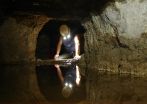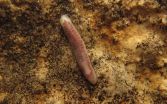(Press-News.org) Typical cave-dwelling organisms, unpigmented and eyeless, were discovered in a karst area located in northeastern Brazil. The organisms were assigned to a new genus and species of freshwater flatworm and may constitute an oceanic relict. They represent the first obligate cave-dwelling flatworm in South America. The study was published in the open access journal ZooKeys.
Freshwater flatworms occur on a wide range of habitats, namely streams, lagoons, ponds, among others. Some species also occur in subterranean freshwater environments.
Brazil has more than 11,000 caves, but their species diversity is largely unknown. Field work by Rodrigo Ferreira, from University of Lavras, Brazil, in a karst area located in northeastern Brazil, has found the first obligate cave-dwelling flatworm in South America. Flatworm researchers from University of Vale do Rio dos Sinos (UNISINOS), Brazil, Ana Leal-Zanchet and Stella Souza, described it as a new genus and species.
The new species, which was named Hausera hauseri, is a typical cave-dwelling organism, unpigmented and eyeless. The genus and species names were proposed in honour to a Hungarian biologist, the late Prof. Dr. Josef Hauser, who immigrated to Brazil and studied freshwater flatworms over many years.
The sampling area of the new species is unique in comparison with other karst areas in Brazil. Most Brazilian limestone formations are located in inner portions of the country, which must have prevented marine groups from colonizing these caves in the past. In contrast, this karst area is located near the sea, and its limestone outcrops are at low altitude, which has allowed different invertebrates to colonize the caves during sea level rises in the past. Thus, the new species may constitute an oceanic relict as is the case of other cave-dwelling invertebrates found in this karst area in northeastern Brazil.
INFORMATION:
Original source:
Leal-Zanchet et al. (2014) A new genus and species for the first recorded cave-dwelling Cavernicola (Platyhelminthes) from South America. Zookeys 442: 1-15. doi: 10.3897/zookeys.442.8199
Brazilian zoologists discovered the first obligate cave-dwelling flatworm in South America
2014-09-25
ELSE PRESS RELEASES FROM THIS DATE:
Water research tackles growing grassland threat: Trees
2014-09-25
MANHATTAN — Two Kansas State University biologists are studying streams to prevent tallgrass prairies from turning into shrublands and forests.
By looking at 25 years of data on the Konza Prairie Biological Station, Allison Veach, doctoral student in biology, Muncie, Indiana, and Walter Dodds, university distinguished professor of biology, are researching grassland streams and the expansion of nearby woody vegetation, such as trees and shrubs. They have found that burn intervals may predict the rate of woody vegetation expansion along streams.
Their latest research ...
Pneumonia bacterium leaves tiny lesions in the heart, study finds
2014-09-25
SAN ANTONIO (Sept. 25, 2014) — The long-observed association between pneumonia and heart failure now has more physical evidence, thanks to research in the School of Medicine at The University of Texas Health Science Center at San Antonio.
The researchers found proof that Streptococcus pneumoniae, the leading cause of community-acquired pneumonia, actually physically damages the heart. The bacterium leaves tiny lesions that researchers detected in mouse, rhesus macaque and human autopsy tissue samples.
"If you have had severe pneumonia, this finding suggests your heart ...
New study shows that yoga and meditation may help train the brain
2014-09-25
New research by biomedical engineers at the University of Minnesota shows that people who practice yoga and meditation long term can learn to control a computer with their minds faster and better than people with little or no yoga or meditation experience. The research could have major implications for treatments of people who are paralyzed or have neurodegenerative diseases.
The research is published online in TECHNOLOGY, a new scientific journal featuring cutting-edge new technologies in emerging fields of science and engineering.
In the study, researchers involved ...
Researchers uncover structure of enzyme that makes plant cellulose
2014-09-25
WEST LAFAYETTE, Ind. - Purdue researchers have discovered the structure of the enzyme that makes cellulose, a finding that could lead to easier ways of breaking down plant materials to make biofuels and other products and materials.
The research also provides the most detailed glimpse to date of the complicated process by which cellulose - the foundation of the plant cell wall and the most abundant organic compound on the planet - is produced.
"Despite the abundance of cellulose, the nitty-gritty of how it is made is still a mystery," said Nicholas Carpita, professor ...
IU-Regenstrief CHICA system improves developmental delay screening and surveillance
2014-09-25
INDIANAPOLIS -- Is my child lagging behind physically, mentally or emotionally? Should I be concerned? When should I ask our pediatrician about it? What can I do to help my child?
A new study from Indiana University School of Medicine and Regenstrief Institute researchers reports that a computerized clinical decision support system is helping parents answer such questions. The system, which they developed to automate pediatric care guidelines, significantly increased the number of children screened for developmental delay at 9, 18 and 30 months of age, as recommended ...
Study identifies gauntlet of obstacles facing migrating pronghorn in greater Yellowstone
2014-09-25
One of North America's last remaining long-distance land migrations, better known as the Path of the Pronghorn, is being threatened by a mosaic of natural gas field development, highway traffic, and fencing in the upper Green River Basin, according to the Wildlife Conservation Society. WCS scientists used a model traditionally applied to identify resource related stopovers for migrating animals in order to identify impediments to migration of pronghorn.
The long-distance travels of the fleet-footed pronghorn through this part of the Greater Yellowstone Ecosystem was the ...
New research outlines promising therapies for small cell lung cancer
2014-09-25
CLEVELAND: Two recently published studies by a research team at University Hospitals (UH) Case Medical Center Seidman Cancer Center have the potential to advance treatments for small cell lung cell cancer (SCLC). This aggressive form of lung cancer has seen no treatment advances in 30 years and "is a disease in urgent need of new drug therapies," write the study's authors.
"In small cell lung cancer, which impacts about 30-40,000 people each year in the United States, there has been no therapeutic progress and very little research," says Afshin Dowlati, MD, lead author ...
Coping techniques help patients with COPD improve mentally, physically
2014-09-25
DURHAM, N.C. -- Coaching patients with chronic obstructive pulmonary disease to manage stress, practice relaxation and participate in light exercise can boost a patient's quality of life and can even improve physical symptoms, researchers at Duke Medicine report.
In a study published online Sept. 25, 2014, in the journal Psychosomatic Medicine, Duke researchers examined how telephone-based coaching could help patients with chronic obstructive pulmonary disease, or COPD, a progressive disease that limits airflow in the lungs.
About 15 million Americans have COPD, and ...
Solar cell compound probed under pressure
2014-09-25
Washington, D.C.— Gallium arsenide, GaAs, a semiconductor composed of gallium and arsenic is well known to have physical properties that promise practical applications. In the form of nanowires and nanoparticles, it has particular potential for use in the manufacture of solar cells and optoelectronics in many of the same applications that silicon is commonly used.
But the natural semiconducting ability of GaAs requires some tuning in order to make it more desirable for use in manufacturing these types of products. New work from a team led by Carnegie's Alexander Goncharov ...
A wriggly solution to a first-world problem
2014-09-25
Australian researchers have achieved groundbreaking results in a clinical trial using hookworms to reduce the symptoms of celiac disease.
The results are also good news for sufferers of other inflammatory conditions such as asthma and Crohn's disease.
In the small trial run over a year, 12 participants were each experimentally infected with 20 Necator americanus (hookworm) larvae.
They were then given gradually increasing doses of gluten – beginning with just one-tenth of a gram per day (the equivalent of less than a one-inch segment of spaghetti) and increasing in ...







